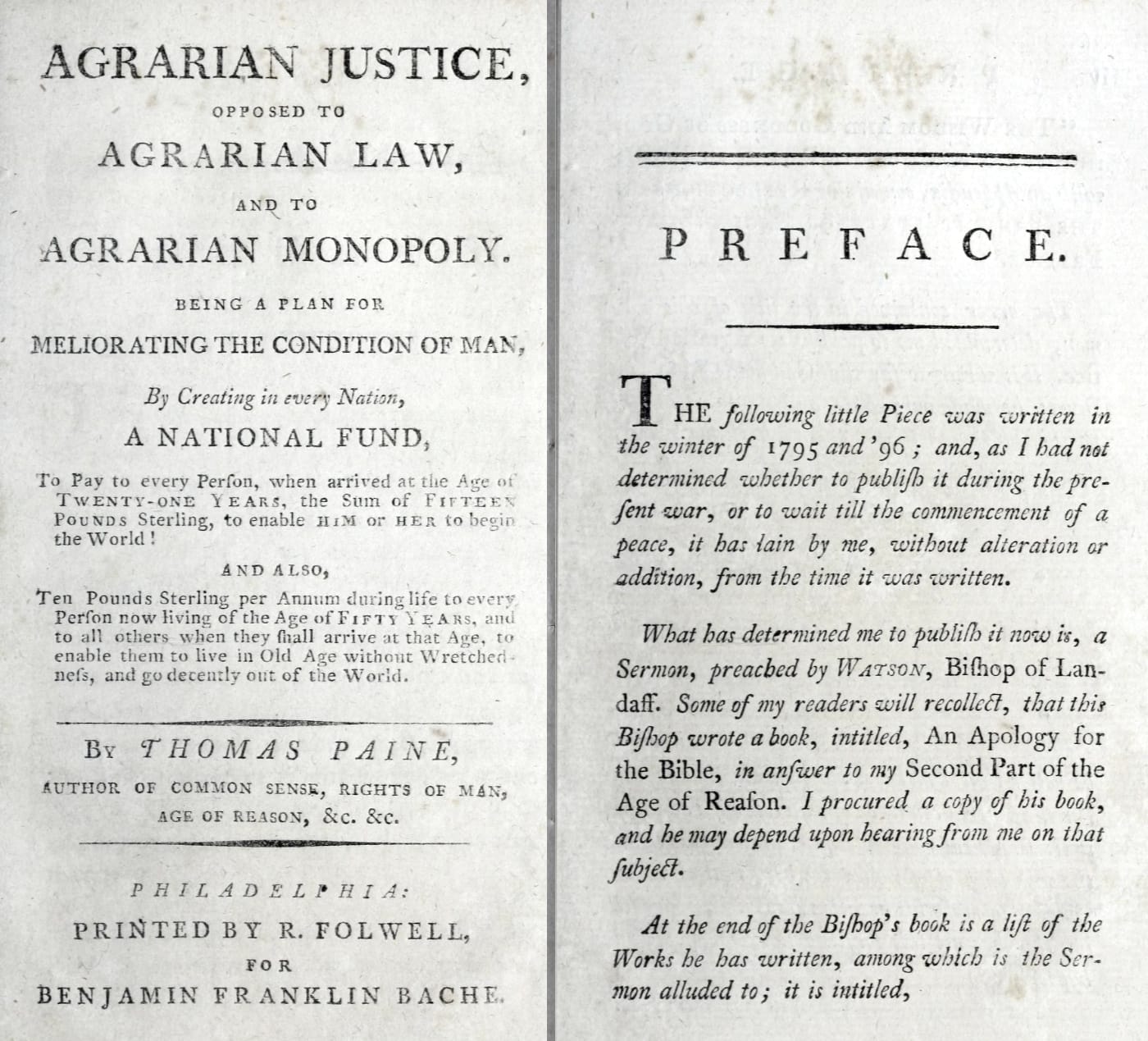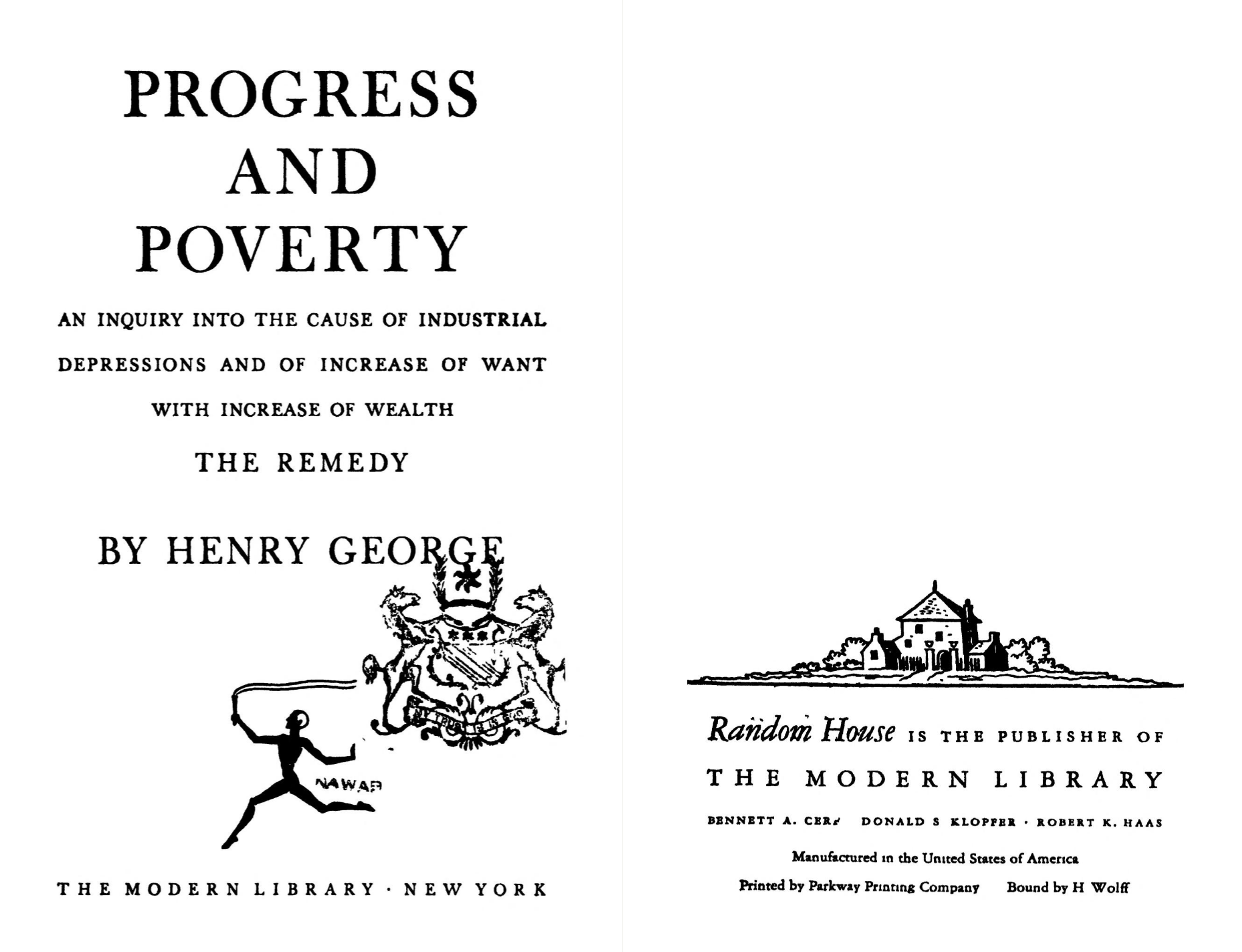The Early History of Guaranteed Minimum Income
Part I (1791 - 1945) • Part II (1946 - 1975) • Part III (1976 - 2025)
Sanders Marble – PhD History, 1998, King's College London
When the Founding Fathers drafted the Declaration of Independence, they defined a core set of natural human rights:
We hold these truths to be self-evident, that all men are created equal, that they are endowed by their Creator with certain unalienable Rights, that among these are Life, Liberty and the pursuit of Happiness.
Recognizing the disparities in land ownership and wealth, Thomas Paine proposed an additional natural right: economic security. Writing in France during the Revolution, in his 1791 treatise Rights of Man, Paine stated:
Man did not enter society to become worse than he was before, nor to have fewer rights than he had before, but to have those rights better secured.
He proposed a broad array of social guarantees to be funded through reduced French military spending and limits on the extravagant spending of the French nobility:
- educational grants
- retirement pensions
- military veteran pensions
- childbirth payments
- marriage payments
In his later essay Agrarian Justice (1796), written for an American audience where almost all available jobs were farming, Paine proposed a more modest social guarantee to be funded by taxes on land transfers:
- £15 ($2,710 in 2025) for all citizens at age 21, for farming equipment or apprenticeship.
- A universal pension fund for the elderly offering a guaranteed annual income of £10 ($1,810 in 2025).
(At that time, the annual salary of an agricultural worker was roughly £23 or $4,155 in 2025.)

While seemingly at odds with his ideals of the minimalist state and a free market, Paine argued this proposed land tax would have little direct impact on commerce or unduly increase the size or power of the federal government.
Paine’s proposed tax was never adopted, and a century later, the American Industrial Revolution generated vast wealth inequality. This led to violent labor confrontations like the Homestead and Pullman strikes. In 1873, Mark Twain published a sharp critique of the rampant greed and corruption that gave the era its name – The Gilded Age: A Tale of Today.
Henry George’s 1879 book Progress and Poverty explained the rapid rise in wealth inequality and the boom/bust economic cycles of the era. This book was widely read and is now regarded as a classic economic study, launching the Progressive Era of social, political, and economic reform. George also focused on land as a key limited resource providing for the common good. He observed that monopolies controlled a disproportionate amount of wealth created by technological change. This allowed those monopolies to further consolidate their wealth and power by speculating on additional land.
To counter this, George proposed a “Single Tax” on undeveloped land to reduce land speculation. This particularly resonated with the working class, as industrialization drove Americans, many of them recent immigrants, to urban factory jobs where they could only rent from the already wealthy rather than acquiring land, and thus wealth, of their own.
In an 1885 speech, George proposed using the “Single Tax” revenues to create a pension and disability system and an unconditional basic income – a “citizen’s dividend”.
Progress and Poverty was second only to the Bible in book sales during this era, but poor health led to an early demise for George. His loss was sorely felt by reformers and the working class – more than 100,000 people passed through Grand Central Palace in New York City at his funeral. But his legacy lived on in Franklin D Roosevelt, who regarded George as one of the great thinkers of the Progressive era, and specifically cited his profound influence on New Deal legislation.

The Great Depression (1929 – 41) brought the “Citizen's Dividend” back into public debate. Private pension systems and relief organizations failed to adequately address the vast scale of the economic crisis under the Hoover Administration. Newly-elected President Franklin D Roosevelt intended to use the resources of the federal government to address the perceived failure of capitalism. His “3 R’s” promised:
- Relief for the unemployed
- Recovery of the economy
- Reform of the institutions responsible for the crisis
Early in his term, labor advocates promoted unemployment insurance and a guaranteed income through income taxes on the wealthy and reduced military spending. FDR worked with congress to pass the Social Security Act in 1935, authorizing a payroll tax to fund unemployment insurance and a guaranteed pension for retirees. Congress also approved $4.9 billion in public works programs to provide relief for the unemployed and stimulate economic recovery. Leading advocates of the working poor continued to state this wasn’t enough – but it was at least some form of the right to guaranteed economic security that Paine originally advocated.
George's legacy also lived on in Louisiana Senator Huey Long, who promoted his “Share Our Wealth” plan in 1934 as a direct challenge to Roosevelt’s New Deal policies, specifically the National Industrial Recovery Act, which he viewed as favoring collusion between big businesses at the expense of the working poor. Seeing that wealth disparity among Americans had created undue suffering during the Great Depression, Long proposed something enormously popular to the voting poor – a progressive tax on America’s wealthiest individuals, capping personal fortunes at $100 million, annual income at $1 million, and inherited wealth at $5 million. The resulting redistribution in wealth would result in an annual guaranteed income of $2,500 – substantially more than labor advocates had previously proposed.
However, by this time, the economic devastation from the Great Depression had greatly reduced the financial resources of even America’s wealthiest and his proposed plan would only result in $1.50 annually for each family. Long’s plan quickly disintegrated after his assassination in 1935, but the popularity of his message still resonated strongly with poor and working-class Americans desperate to get back on their feet.
By 1940, the Roosevelt administration negotiated multiple spending bills designed to reinvigorate the US economy and better prepare the armed forces for a potential conflict with either Germany or Japan. At the end of 1941, the US would find itself suddenly at war with both nations. All limits on federal spending and concerns about rising federal debt were urgently cast aside, with massive amounts of defense spending enabling the US to become the “Arsenal of Democracy”. By the end of World War II, the United States would find itself in a preeminent economic and military position – the first global superpower.
But what would America do with that power?
Continue to Part 2 – The History of Guaranteed Minimum Income and "The Great Society"
Part I (1791 - 1945) • Part II (1946 - 1975) • Part III (1976 - 2025)
Works Referenced
George, Henry. “Progress and poverty; an inquiry into the cause of industrial depressions, and of increase of want with increase of wealth. The remedy.” Fifth Edition, New York, Appleton, 1879, https://archive.org/details/cu31924013685460/page/n5/mode/2up.
Halloran, Daniel F. “Progress against Poverty: The Governmental Approach.” Public Administration Review, vol. 28, no. 3, 1968, pp. 205–13. JSTOR, https://doi.org/10.2307/974121. Accessed 11 May 2025.
Jeansonne, Glen. “Challenge to the New Deal: Huey P. Long and the Redistribution of National Wealth.” Louisiana History: The Journal of the Louisiana Historical Association, vol. 21, no. 4, 1980, pp. 331–39. JSTOR, http://www.jstor.org/stable/4232034. Accessed 7 May 2025.
Officer, Lawrence H., "Exchange Rates Between the United States Dollar and Forty-one Currencies,", MeasuringWorth, 2025, URL: http://www.measuringworth.com/exchangeglobal/.
Paine, Thomas. "Agrarian Justice", in The Complete Writings of Thomas Paine, ed. Philip S. Foner, 2 vols., (New York: Citadel Press, 1969). Thomas Paine: Collected Writings (LOA #76): Common Sense / The American ... - Thomas Paine - Google Books.
Roberts, James M. “‘Progress and Poverty’s Continuing Challenge.” The American Journal of Economics and Sociology, vol. 30, no. 3, 1971, pp. 301–16. JSTOR, http://www.jstor.org/stable/3485163. Accessed 6 May 2025.
Seaman, John W. “Thomas Paine: Ransom, Civil Peace, and the Natural Right to Welfare.” Political Theory, vol. 16, no. 1, 1988, pp. 120–42. JSTOR, http://www.jstor.org/stable/191650. Accessed 6 May 2025.
Zecker, Robert M. “A ‘Plan for Plenty’: The IWO Tames Capitalism.” “A Road to Peace and Freedom”: The International Workers Order and the Struggle for Economic Justice and Civil Rights, 1930-1954, Temple University Press, 2018, pp. 55–96. JSTOR, https://doi.org/10.2307/j.ctt21216zn.7. Accessed 11 May 2025.
“$1 in 1796 → 2025 | Inflation Calculator.” Official Inflation Data, Alioth Finance, 16 May. 2025, https://www.officialdata.org/us/inflation/1796?amount=1.
